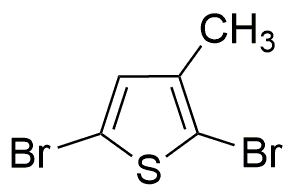2,5-Dibromo-3-methylthiophene is widely utilized in research focused on:
- Organic Electronics: This compound is used in the development of organic semiconductors, which are essential for creating flexible electronic devices like OLEDs (Organic Light Emitting Diodes) and organic solar cells.
- Pharmaceuticals: It serves as an intermediate in the synthesis of various pharmaceutical compounds, aiding in the creation of new drugs with improved efficacy and reduced side effects.
- Material Science: The compound is valuable in the production of specialty polymers and coatings, enhancing material properties such as conductivity and thermal stability.
- Agricultural Chemicals: It can be utilized in the formulation of agrochemicals, contributing to the development of pesticides and herbicides that are more effective and environmentally friendly.
- Research and Development: As a building block in synthetic chemistry, it supports academic and industrial research aimed at discovering new chemical reactions and materials.
General Information
Properties
Safety and Regulations
Applications
2,5-Dibromo-3-methylthiophene is widely utilized in research focused on:
- Organic Electronics: This compound is used in the development of organic semiconductors, which are essential for creating flexible electronic devices like OLEDs (Organic Light Emitting Diodes) and organic solar cells.
- Pharmaceuticals: It serves as an intermediate in the synthesis of various pharmaceutical compounds, aiding in the creation of new drugs with improved efficacy and reduced side effects.
- Material Science: The compound is valuable in the production of specialty polymers and coatings, enhancing material properties such as conductivity and thermal stability.
- Agricultural Chemicals: It can be utilized in the formulation of agrochemicals, contributing to the development of pesticides and herbicides that are more effective and environmentally friendly.
- Research and Development: As a building block in synthetic chemistry, it supports academic and industrial research aimed at discovering new chemical reactions and materials.
Documents
Safety Data Sheets (SDS)
The SDS provides comprehensive safety information on handling, storage, and disposal of the product.
Product Specification (PS)
The PS provides a comprehensive breakdown of the product’s properties, including chemical composition, physical state, purity, and storage requirements. It also details acceptable quality ranges and the product's intended applications.
Certificates of Analysis (COA)
Search for Certificates of Analysis (COA) by entering the products Lot Number. Lot and Batch Numbers can be found on a product’s label following the words ‘Lot’ or ‘Batch’.
*Catalog Number
*Lot Number
Certificates Of Origin (COO)
This COO confirms the country where the product was manufactured, and also details the materials and components used in it and whether it is derived from natural, synthetic, or other specific sources. This certificate may be required for customs, trade, and regulatory compliance.
*Catalog Number
*Lot Number
Safety Data Sheets (SDS)
The SDS provides comprehensive safety information on handling, storage, and disposal of the product.
DownloadProduct Specification (PS)
The PS provides a comprehensive breakdown of the product’s properties, including chemical composition, physical state, purity, and storage requirements. It also details acceptable quality ranges and the product's intended applications.
DownloadCertificates of Analysis (COA)
Search for Certificates of Analysis (COA) by entering the products Lot Number. Lot and Batch Numbers can be found on a product’s label following the words ‘Lot’ or ‘Batch’.
*Catalog Number
*Lot Number
Certificates Of Origin (COO)
This COO confirms the country where the product was manufactured, and also details the materials and components used in it and whether it is derived from natural, synthetic, or other specific sources. This certificate may be required for customs, trade, and regulatory compliance.


